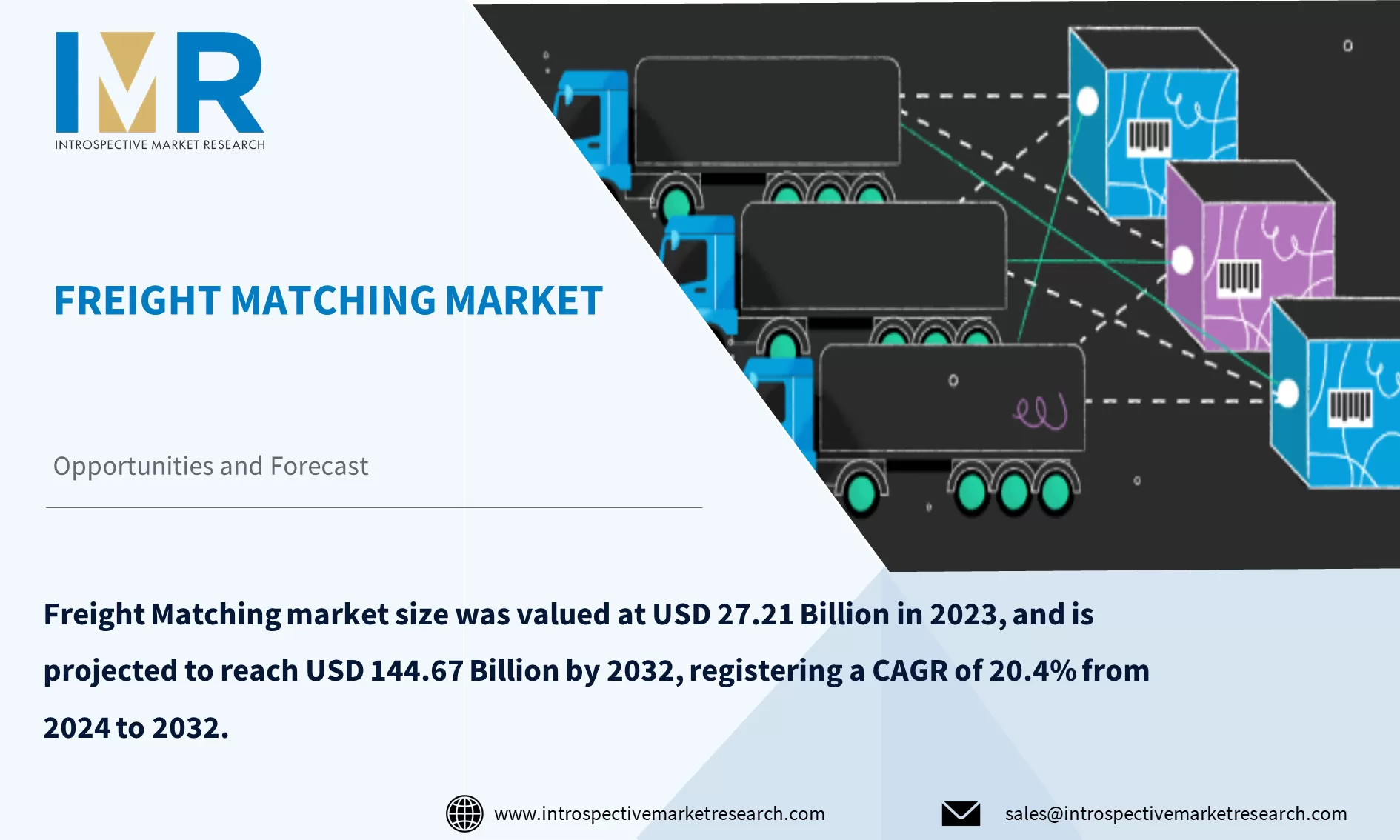Freight Matching Market
According to a new report published by Introspective Market Research, titled, ?Freight Matching Market by Mode and End User: Global Opportunity Analysis and Industry Forecast, 2024?2032,?
the global Freight Matching market size was valued at USD 27.21 Billion in 2023, and is projected to reach USD 144.67 Billion by 2032, registering a CAGR of 20.4% from 2024 to 2032.
Freight matching is crucial in logistics and transportation, connecting shippers with carriers to fulfill cargo demands. It eliminates the waste of carriers' time and resources, enhances logistics chain management, and minimizes freight costs. Technological advancements have improved freight matching, using platforms like load boards, mobile apps, and automated matching systems. AI and ML technologies enhance matching efficiency, optimize load space, and predict empty miles, reducing carbon emissions.
According to The Freight Matching Market is segmented into Type, End User, and region. By Mode, the market is categorized into Rail Freight, Road Freight, Ocean Freight, and Air Freight. By End User, the market is categorized into 3PLs, Brokers, Shippers, and Carriers. By region, it is analyzed across North America (U.S.; Canada; Mexico), Europe (Germany; U.K.; France; Italy; Russia; Spain, etc.), Asia-Pacific (China; India; Japan; Southeast Asia, etc.), South America (Brazil; Argentina, etc.), Middle East & Africa (Saudi Arabia; South Africa, etc.).
Blockchain technology is gaining attention in freight matching as an open platform for coordinating transactions and information flow in the logistics sector. It improves transparency, trust, and efficiency by incorporating decentralized ledgers. Blockchain can also automate freight matching activities, such as integrating smart contracts, which drive deals between shippers and carriers without intermediaries. As blockchain progresses, it could significantly enhance the supply chain ecosystem.
Integration with logistics providers offers a promising market for freight matching, providing value-added services, better operating models, and competitive advantage. By enhancing freight matching solutions, logistics providers can reach a wider range of shippers and carriers, increase customer satisfaction, leverage industry knowledge, and address regulatory compliance, market access, and service differentiation.
Global Freight Matching Market, Segmentation
The Freight Matching market is segmented based on Mode, End User, and region.
Mode:
Road freight is a popular segment in the freight matching market due to its adaptability, competitive nature, and well-developed road network. With thousands of companies, it offers a wide range of routes and competitive pricing. With online shopping and just-in-time inventory management, road freight delivery demands faster, on-demand services, making it a crucial segment in the logistics industry.
End User:
Brokers dominate the freight matching market by acting as intermediaries between shippers and carriers. They use market knowledge, industry connections, and connections to ensure efficient routes and timely allocation of freight loads. Decentralized digital platforms and real-time monitoring improve their work output. Brokers also provide expertise and assistance, addressing logistics issues and enhancing supply-chain effectiveness and reliability.
Region:
North America leads in the freight matching market due to its robust logistics sector, strong transport connections, numerous leading logistics companies, a competitive business environment, a good legal framework, and a suitable economic climate. Government programs, infrastructure growth, and innovative technologies further strengthen the market's prospects. This diverse industry and supply chain networks provide ample transportation requirements for freight-matching providers.
Some of The Leading/Active Market Players Are-
- 10-4 Systems (United States)
- C.H. Robinson (United States)
- Convargo (France)
- Convoy (United States)
- DAT Solutions (United States)
- Echo Global Logistics (United States)
- Flexport (United States)
- Freightera (Canada)
- Freightos (Israel)
- J.B. Hunt Transport Services (United States), and Other Active Players
Key Industry Developments
- In June 2024, Freight Technologies, Inc., a logistics technology solutions company, announced a significant milestone in expanding its Fr8Radar module within its Fr8App platform. The AI-powered freight-matching platform provides a real-time portal for B2B cross-border and domestic shipping within the USMCA region.
- In July 2023, Truckstop announced it had acquired the Freight Friend cloud-based capacity and freight management solution that harnesses the power of AI to manage relationships, find capacity, and match freight with greater efficiency.
Key Findings of the Study
- The global Freight Matching market, valued at $27.21 billion in 2023, is projected to reach $144.67 billion by 2032, growing at a CAGR of 20.4%.
- Technological advancements, including AI, ML, and blockchain, enhance matching efficiency, optimize load space, and reduce carbon emissions.
- Road freight remains a dominant segment due to its flexibility, extensive routes, and competitive pricing, driven by online shopping and just-in-time inventory demands.
- North America leads the market due to its strong logistics sector, robust transport infrastructure, and supportive government programs.






